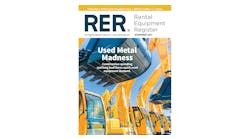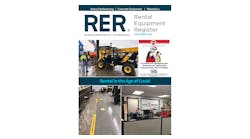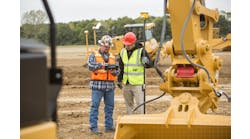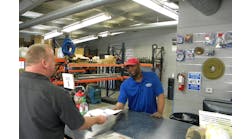Buoyed by the newly published Statement of Best Practices of General Training and Familiarization for Aerial Work Platform Equipment, the subject of operator training programs is at the forefront of rental industry dialog once again. Not only is operator training and familiarization the responsibility of the rental company that is supplying aerial work platform equipment, but it is also an important and valuable service to provide customers that can both bolster revenue with new business and benefit customer relationships.
According to American Work Platform Training, operator training is still minimal in North America, despite the fact that it is required by American National Standards Institute (ANSI) standards and Occupational Safety and Health Administration (OSHA) regulations. “A training program is a tool that anyone who contemplates delivering training needs to have in place,” says Tony Groat, International Powered Access Federation North American representative and AWPT executive vice president. “That includes instructor training and operator training.”
The new Best Practices guidance was jointly developed by the American Rental Association, the Association of Equipment Manufacturers, the Scaffold Industry Association, the Associated Equipment Distributors and IPAF. Its purpose is to provide general guidance and best practices in training and safe use of aerial work platform equipment and to summarize certain standards and regulations published by ANSI and OSHA.
Despite the fact that there are many programs available to train operators on the safe use of AWP equipment, there continues to be a lack of properly trained operators, according to the Best Practices document, which aims to define the minimum standards for establishing quantitative requirements to be met for the qualification of operators and their trainers. It also recommends the best practices for meeting the minimum requirements of familiarization. Section 8.5.1 of ANSI/SIA A92 standards lists what should be included in operator general training, and Section 8.5.3 of those standards addresses what should be included in familiarization, but neither defines a minimum standard. The Best Practices document was created to fill in the gap.
“It's really good in terms of helping dealers understand their obligations, employers understand their obligations and it lays out, because there's a lot of confusion in the industry about what is operator training and familiarization, that they're two entirely different things, and a lot of times I think operators are familiarized and they confuse that with training,” explains Teresa Kee, director, environmental health and safety for Deerfield, Ill.-based NES Rentals.
“People need to understand that there is a fundamental difference between proper training and familiarization and that both are required,” says Groat. “General training consists of both classroom and hands-on instruction on a category of machines, including safe operating procedures and recognition of potential hazards. Familiarization is information given to a trained operator regarding control functions and safety devices on a specific model prior to operation. I think we want to keep this new Best Practices document out there in front of everybody and just keep raising the bar on this issue.”
For rental businesses that offer AWPs for rent, safe operator training is an obligation — to both employees and customers. Determining how to best provide that training is the first step and one worthy of careful consideration.
“The tasks and administrative activities and responsibilities involved in implementing a program are numerous and very involved,” says Steve Phillips, vice president for health, safety and the environment at Millville, N.J.-based Trico Lift, which recently achieved the milestone of 12 consecutive months without any lost work time or recordable incidents. “It takes a significant commitment and it begins with the conviction that your internal safety programs are top-notch and current. We train up to as many as 1,500 people, mostly operators, in a year. These people are looking for us for safety leadership and expertise and we take that role very seriously.”
Phillips also references the new Best Practices and General Training document and recognizes its value in outlining the difference between general training and familiarization, and the accountabilities for that training.
The training table
Rental businesses have several choices to consider for how to train their employees to effectively educate rental customer operators on the safe use of aerial work platforms. NES Rentals recently announced it would become an AWPT training center in the Chicago market, offering operator training based on the IPAF training program.
“Because we already offer operator training programs from various aerial work platform manufacturers, it was a natural progression for us to add AWPT training to our programming,” says Kee. “Successful completion of the AWPT program leads to the issuance of an internationally recognized Powered Access Licensed registration card.”
A benefit of the AWPT training program as compared to an OEM-provided training program, according to Kee, is that the training is provided by a separate third-party, independent entity that can certify the rental company's instructors to train its employees and customer operators, and provide continuous monitoring. Because the AWPT training center has to pre-register the date, time and location where it will hold training courses, an official from the IPAF training program can show up at any time to monitor that training course.
“While both IPAF and AWPT are dedicated to providing comprehensive training in the safe use of aerial work platforms and mast-climbing work platforms, neither organization performs the actual training,” explains Groat. “Training is done by those members of IPAF, like NES, who have met stringent requirements and are certified as authorized training centers. We provide them with the training materials, then follow up and monitor the way the actual training is conducted. It's the only program available that has checks and balances to ensure consistent implementation of the training.”
NES' newly opened AWPT training center, located in the Chicago suburb of Des Plaines, Ill., is the company's first. It offers customer training and will also conduct operator training for all branch employees who operate or occupy aerial work platforms.
Rental companies can also turn to an unaffiliated independent training provider such as Blaine, Wash.-based IVES Training Group, which trains and certifies beginners and general operators of equipment from designated locations in the United States and Canada, and also offers custom on-site training. The company currently offers programs from its locations in California, Oregon, Washington, Utah, Hawaii, Nevada, Texas and British Columbia, and has more locations planned due to growing demand for AWP safe operator training.
“IVES works with several rental companies that act as host sites for our trainer programs and has for several years,” says Rob Vetter, IVES director of training. “These sites enjoy financial compensation for this through commissions and equipment rental and intangible compensation through the positive exposure of their products and services. They receive all this with little effort or investment and incur no costs associated with diverting resources and/or personnel away from their core business, and we take on the liabilities as well as the maintenance and delivery of the training programs.”
IVES' programs include training materials, and provide follow-up technical support via phone, email and Internet resources.
Another option is for rental businesses to team up with their AWP manufacturer partners to provide effective operator training and resources. Manufacturers have the benefit of equipment knowledge, safe-use guidelines, and OSHA rules and regulations.
“We have a 40-year background of the equipment, from its inception and development to all of its various applications and the progression that's happened over 40 years, and all of the safety and the rules and regulations that have developed over the years,” says Tom Hickey, an AWPT certified senior instructor and training programs manager, safety for McConnellsburg, Pa.-based JLG Industries. “And the accidents that caused those rules and regulations, they are intimately familiar, and the program has been built on that.”
In addition, according to the Best Practices document, and as stated in Section 4 of the ANSI/SIA A92 standard, it is the responsibility of AWP manufacturers to develop and offer training and training materials.
“In general, we believe as manufacturers that it is paramount for rental companies to be able to provide proper training with the rental of aerial equipment, especially since the sad statistics show that operator error is the most common cause for accidents,” says Ebbe Christensen, president and CEO of ReachMaster Inc., Kingwood, Texas.
In fact, according to AWPT, more than 90 percent of accidents on AWPs are the result of operator error. In a recent OSHA report, safety violations while working at height were among the most common citations issued and it is believed that a lack of proper training was a contributing factor in many of those instances.
“Nobody knows their products better than the manufacturers, and it is natural that a correlation between the manufacturer and the industry is a key element of proper training,” Christensen adds. “Organizations like IPAF further provide a foundation for training that can be adopted by both rental companies and manufacturers.”
No matter the source of AWP training expertise, it is the obligation of a rental business to its customers. Not only are operator training and familiarization both mandatory, as stated in the new Best Practices resource, but they also strengthen business relationships and garner trust, which can lead to new customers and new business from existing ones.
“I do see training becoming a revenue stream at some point, but if nothing else it's a valuable service to our customers,” says Kee. “And frankly I do see it as a real opportunity to get leads. You may have customers that you're just starting to get to know, and they come in the class and they start to listen to some of the things that you're talking to them about and it's kind of an eye-opening experience, and we're starting to see interest from new customers.”
For more information, or to download a free copy of the Statement of Best Practices of General Training and Familiarization for Aerial Work Platform Equipment, visit awpt.org.
Do's and Don'ts for Safe Aerial Work Platform Operation
Top 11 Operator Safety Mistakes
Provided by Trico Lift, Millville, N.J.
- Assuming that different models and brands of lifts operate the same
- Failure to use fall protection when required
- Not conducting a thorough pre-use inspection and function test
- Failure to maintain safe clearance around overhead power lines
- Not conducting a thorough jobsite inspection
- Using platform mid rail and top rail to gain additional height or reach
- Driving the machine elevated when it is possible to lower it before repositioning
- Not using ground guides
- Not securing the work area to prevent other people or objects from entering the area
- Placing the platform in an unsafe position — below falling objects, other elevated equipment, etc.
- Filling platforms with excess debris, such as tools that create a tripping hazard for occupants, falling hazards for those below, and an overweight condition for the machine that may result in a tip over.
11 Things Operators Should Know
Provided by IVES Training Group, Blaine, Wash.
- Make sure you receive safety training on the actual type of equipment you are about to use.
- Get authorization from your employer before using an aerial lift.
- Inspect the equipment before you use it and make sure you know how to use the emergency/auxiliary controls. Read the manual!
- Inspect the site and be especially wary of poor roadway conditions, pedestrian vehicle traffic and energized power lines.
- Use the required personal protective equipment
- Always keep a clear view of the travel path.
- Look in the direction of travel - this includes up and down!
- Try to minimize travelling while elevated.
- Keep both feet planted on the deck and stay inside the guardrails.
- Elevate on level ground only.
- Stay alert and aware and if anything strikes you as being wrong, STOP!





